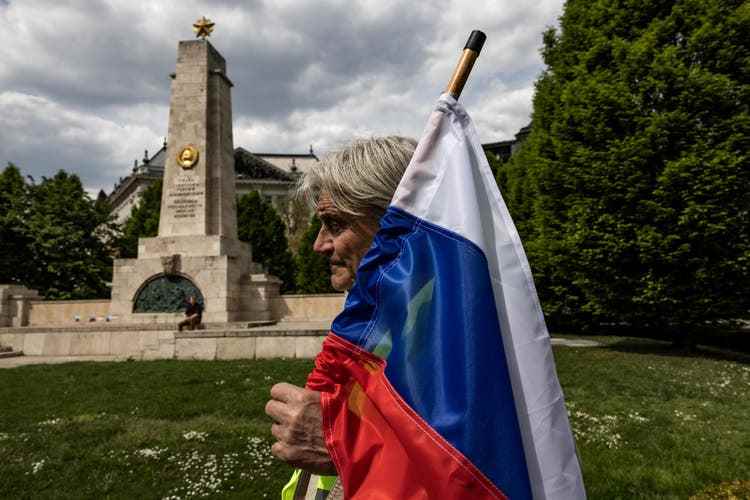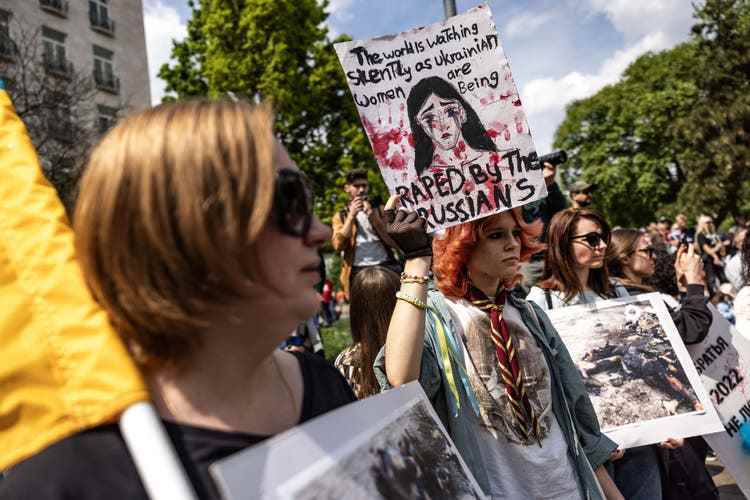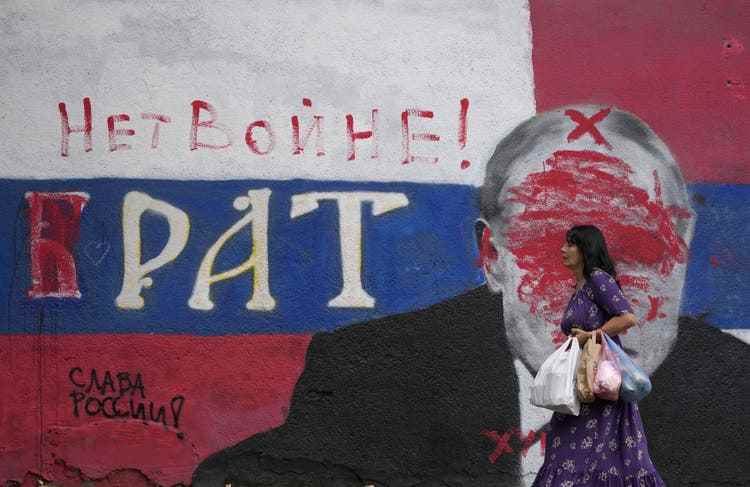On the journey from Warsaw via Budapest to Belgrade we meet Ukrainian refugees and Russian emigrants. Some are fleeing from Russian grenades, others from EU sanctions and also from Putin.
A woman refugee from Ukraine listens to President Zelensky’s speech in Hungary.
When the Polish long-distance train “Batory” finally approaches the Hungarian city of Györ, night is already falling. The man with the “Los Angeles” denim jacket, who has been pacing around in the train car the whole time, keeps looking outside and seems to be counting the stops. Because of flooding in the Czech Republic and on the Danube, the train has been diverted, the delay is growing and with it his unrest. Now “Los Angeles” thinks it has reached its destination in Budapest. But the train just roars through. We’re only in Gyor.
The United Nations refugee agency (UNHCR) counted almost a million border crossings by Ukrainians into Hungary after the first months of the war. But most of the war refugees from Hungary soon move on to Western Europe. Because of Viktor Orban’s pro-Russian policies, many Ukrainians do not feel welcome in the country.
However, by the summer nearly 27,000 Ukrainians had received temporary Hungarian refugee status. In addition, a few thousand are likely to be in the country unannounced. The city of Budapest, which is governed by the opposition, warmly welcomes the Ukrainians, not least with Ukrainian inscriptions on trams, metro and buses.
However, Russian is heard more often than Ukrainian in Budapest. Hundreds of Russian tourists are bustling in the center of the Hungarian capital. Two elderly women from St. Petersburg complain about the high prices at the Ferris wheel on Deak Ferenc ter, a large square not far from Parliament. They arrived by plane via Belgrade.

A supporter of Putin at a pro-Russian rally in Budapest.

Women protest in Budapest against the Russian attack on Ukraine.
Belgrade as the Russian gateway to Southeast Europe
EU candidate Serbia is one of the few countries in Europe that has not adopted the Brussels sanctions against Russia. Air Serbia flies to Moscow twelve times a week. Belgrade has thus become the Russian gateway to Southeast Europe. From here it often goes on to either Montenegro, Spain or Cyprus – exactly where the Russians are traditionally drawn to.
“Good day! We wish you a good appetite», two young waiters practice their Russian a few steps away in a posh restaurant. Budapest is dressing up for the new guests. Many apartments in the city center are rented out to tourists during the summer months. But in the high-rise districts behind Varosliget Park, Russians and Ukrainians also meet.
“Some guys have been peeing in our elevator since the war,” complains a Russian woman in an interview. “These are the Ukrainians who want refugee status,” she believes she knows. The forty-something has been living in Budapest for a few years and keeps her head above water with art.
She doesn’t like Vladimir Putin, but she thinks that the blanket hostilities against Russians unite long-established and new emigrants behind the Kremlin’s policies. The Russian embassy, which is asking its citizens to report anti-Russian incidents so that they can be helped, is also helping.
A Russian man in the park complains that Ukrainians insist on speaking English to him. He blames NATO for the war. Volodymyr Zelensky would take better care of the well-being of his people than want to join the EU and NATO. In everyday life, Russians and Ukrainians mostly avoided each other, says the man, who describes himself as a manager and as apolitical.
Oddly enough, leaving Hungary takes longer than entering the Republic of Serbia. All travelers have to get off the bus and, like in the past at the border with the Soviet Union, line up in single file for passport control.
Also in line are Oleg, Xenia and Masha from Kharkiv, Ukraine. The grandfather, his daughter and the granddaughter have been living in Warsaw since the beginning of March, now they want to meet the rest of the family in Montenegro.
“It was supposed to be a holiday trip, some relaxation, but who can forget this terrible war?” says Xenia and invites them to their hometown thirty kilometers west of the Russian border for the time after the war. “It’ll be fine again, we’ll win,” she says confidently. Grandfather Oleg is grimly silent all the time. Xenia’s two older daughters had gone to Montenegro at the beginning of the war, the rest of the family was stranded in Poland. Russians are not to be found in this bus.
During the stopover in Novi Sad in Vojvodina, as before in Budapest, small Ukrainian flags can only rarely be seen in the streets. That changes abruptly in the Serbian capital of Belgrade. Here large Gazprom advertising posters evoke Serbian-Russian friendship.
Large graffiti at the Defense Ministry bombed by NATO in 1999 claim that Kosovo is Serbia’s heart and Russia is by Belgrade’s side. However, many wall paintings are ambiguous. In the Vracar district, for example, Putin is shown with the Serbian and Russian flags, but with black mafioso glasses.
United as the losers of history
All sorts of theories about Serbia’s close fraternity with Russia can be heard at the Kalenic neighborhood market. Just as Serbia gave Kosovo autonomy in 1974, Russia made the same mistake in 1991 and granted Ukraine independence, a saleswoman explains. “Belgrade and Moscow are at a disadvantage,” she continues. But war is bad, because the poor always pay the greatest price.
In discussions with passers-by, however, it becomes clear that many Serbs see their people as the pillars of the defunct federation, similar to what Russians do when they look at the Soviet Union. Russians and Serbs see themselves as history’s losers and, last but not least, as victims of NATO.
Both events, the collapse of Yugoslavia and the NATO attack, are an integral part of President Aleksandar Vucic’s government propaganda. But the Serb, like his Hungarian political friend Viktor Orban, is a pragmatic turnneck who has known for years how to play Brussels and Moscow off against each other.
While friendship with Russia in Serbia has historical roots and is rooted in broader sections of the population, in Hungary political proximity to Russia is primarily a top-down government issue. Its boss, Viktor Orban, sees Moscow as an ally in its many conflicts with the EU, while Hungarians themselves have little historical reason to feel particularly close to Russia.
After all, the Russian-dominated Soviet leadership bloodily crushed the Hungarian uprising in 1956. In Budapest it is often said that it was the Soviets and not the Russians back then. The trauma of 1956 still exists in Hungary. But since Orban came to power in 2010, it has been increasingly competed with and pushed aside by the Trianon trauma: by mourning for “Greater Hungary”.
In 1920, after the First World War, Hungary’s territory was reduced by two thirds by the victorious powers in the Treaty of Trianon. Neither Russia nor the Soviet Union were among the signatories of this shameful peace. The signatories were France, Italy and Great Britain.
More Russians than Ukrainians in Serbia
Since February 24, Belgrade and Budapest have attracted many IT specialists from Russia, who are fleeing the consequences of EU and US sanctions with their companies. A small Facebook group led by a Russian IT specialist has caused a sensation because it brings together Russians, Ukrainians and Belarusians who have repeatedly demonstrated against the war. But a few Russians loyal to Putin have also settled in the two capitals. Be it because life in Europe is more comfortable now, or be it to monitor one’s own compatriots.

An ambiguous mural in Belgrade. Originally for Putin («Brother»), then painted over («No war!»).
There are no reliable figures on the number of Russian new arrivals in Serbia because many Russian exiles continue to travel. Estimates are circulating in Belgrade that assume 20,000 to 30,000 new Russian immigrants. That exceeds the number of 14,000 Ukrainian war refugees. Only 870 of them have been granted temporary refugee status. Some Serbs complain that the many Russians have pushed up real estate prices by 15 percent.
Serbia and Montenegro, each with almost 2 percent of all Russian exiles, have been the most popular destinations in Europe since the outbreak of war. However, according to a survey by the opinion research institute OK Russians, many more Russians were drawn to Turkey (25 percent), Georgia (23 percent) and Armenia (14 percent).
According to the same survey, almost half of these nine exiles work in the IT sector (45 percent), followed by managers and cultural workers (16 percent each), teachers (14 percent) and journalists (8 percent).
Talking to Russians in Serbia turns out to be not as easy as in Budapest. After the journalist’s first question, three women on a local train near Belgrade say goodbye, saying they don’t speak Serbian. When asked in her native language, one says she doesn’t speak to the media.
The Serbs are pragmatists
A Serbian-Russian couple on a long-distance train insists on going on vacation in peace. They don’t want to know anything about the war in Ukraine. The young Russian says she’s just happy to be here in Serbia, to be able to move around freely and live in peace.
In any case, the Serbs are above all pragmatists. This is shown by a walk across the old Kalemegdan fortress in Belgrade at the confluence of the Sava and Danube. On the one hand, a T-shirt stand prominently placed at the entrance to the park offers the “Z” vests of the Russian invaders, which are mostly banned in the EU.
On the other side, however, are T-shirts with the likeness of a frustrated-looking Putin. “Everything is going according to plan” it says. “Unfortunately, both versions don’t sell well,” complains the seller, “who has money for new camisoles with this inflation.”
